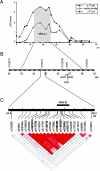IRAK-M is involved in the pathogenesis of early-onset persistent asthma
- PMID: 17503328
- PMCID: PMC1867098
- DOI: 10.1086/518259
IRAK-M is involved in the pathogenesis of early-onset persistent asthma
Abstract
Asthma is a multifactorial disease influenced by genetic and environmental factors. In the past decade, several loci and >100 genes have been found to be associated with the disease in at least one population. Among these loci, region 12q13-24 has been implicated in asthma etiology in multiple populations, suggesting that it harbors one or more asthma susceptibility genes. We performed linkage and association analyses by transmission/disequilibrium test and case-control analysis in the candidate region 12q13-24, using the Sardinian founder population, in which limited heterogeneity of pathogenetic alleles for monogenic and complex disorders as well as of environmental conditions should facilitate the study of multifactorial traits. We analyzed our cohort, using a cutoff age of 13 years at asthma onset, and detected significant linkage to a portion of 12q13-24. We identified IRAK-M as the gene contributing to the linkage and showed that it is associated with early-onset persistent asthma. We defined protective and predisposing SNP haplotypes and replicated associations in an outbred Italian population. Sequence analysis in patients found mutations, including inactivating lesions, in the IRAK-M coding region. Immunohistochemistry of lung biopsies showed that IRAK-M is highly expressed in epithelial cells. We report that IRAK-M is involved in the pathogenesis of early-onset persistent asthma. IRAK-M, a negative regulator of the Toll-like receptor/IL-1R pathways, is a master regulator of NF- kappa B and inflammation. Our data suggest a mechanistic link between hyperactivation of the innate immune system and chronic airway inflammation and indicate IRAK-M as a potential target for therapeutic intervention against asthma.
Figures



References
Web Resources
-
- Center for Medical Genetics, Marshfield Medical Research Foundation, http://research.marshfieldclinic.org/genetics/
-
- Ensembl Genome Browser, http://www.ensembl.org/
-
- The GDB Human Genome Database, http://gdbwww.gdb.org/
-
- National Center for Biotechnology Information, http://www.ncbi.nlm.nih.gov/
References
Publication types
MeSH terms
Substances
Grants and funding
LinkOut - more resources
Full Text Sources
Other Literature Sources
Medical
Molecular Biology Databases
Miscellaneous

